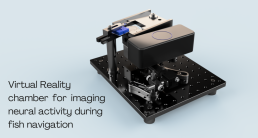A Connaught New Researcher Award to CSB Professor Qian Lin will combine engineering, neuroscience, game design and AI to reveal new insights on how the brain controls movement through space.
In an aquarium in Lin’s lab, a fish sees two paths and swishes its tail to take the left path. A sensor catches the movement and the fish sees its environment change. Fish neurons participating in this trained decision glow and the light is captured by a multi-photon camera focused on its brain. The neural activity is then analyzed using machine learning to identify patterns involving specific neurons.
The path in the aquarium is a virtual reality (VR) projection built using the Unity game engine, and the fish’s tail is its game controller. Lin has engineered a prototype for this VR rig, but support from the Connaught Fund will allow her team to construct a more advanced and reliable platform for training fish.
Zebrafish are a well studied model animal with a 1mm thick juvenile brain that is transparent to a multi-photon microscope. Zebrafish in Lin’s lab will be trained from a young age to memorize a path in VR and the glowing activity of juvenile trained neurons will be imaged.
Previously, fish were trained to avoid a path through electric currents, but Prof Lin’s experiments will test rewarding the fish with chemical treats (adenosine triphosphate) for following the correct path.
Navigating a path depend on the communication of multiple brain regions, which develops as a function of experience. The neural dynamics that support these cognitive behaviours and the underlying neural mechanisms are unclear.
“We will extract neural activity from our imaging data and use machine learning/AI tools or factor analysis to reveal the latent dynamics,” explains Lin. “Clustering analysis categorizes the neurons into different functional groups and we use either nonlinear or linear dimension reduction, to help us to visualize and interpret the neural dynamics.”
By observing how multiple brain regions communicate through the cerebellum as part of cognitive behaviour, Prof Lin aims to build a systems map of spatial-encoding neurons that respond to cognitive inputs.
“The fish brain is much less complex than the human brain, so we can assess details of cognition in fewer neurons,” explains Lin “If the computational principles we find in one animal model have general meaning, they can be applied to other animal models including human as well, just at a different scale.”
Congratulations, Professor Qian Lin!

